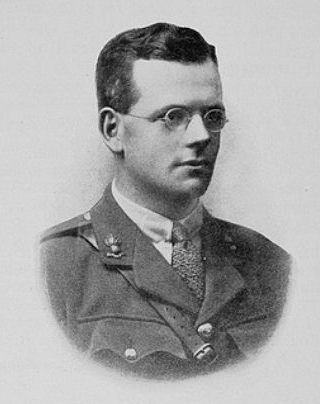
Figure 1. 2nd Lieutenant Leonard Joseph Bladwell, R.E.
(Image from Wycliffe and the War)
2nd
Lieutenant
LEONARD
JOSEPH BLADWELL
Royal
Engineers
by
Lieutenant Colonel (Retired) Edward De Santis,
MSCE, PE, MinstRE
U.S. Army Corps of Engineers
(June 2023)

Figure 1. 2nd Lieutenant
Leonard Joseph Bladwell, R.E.
(Image from Wycliffe and the
War)
1. INTRODUCTION
Leonard Joseph Bladwell was an interesting young man. He was a vegetarian, the first that I ever came across during many years of researching men who served in the Great War of 1914-1918. He followed a vegetarian diet during his years in school and continued with that diet while he served in the Army. He considerably impressed his companions by his ability to go for long spells without food or drink.[1]
He never did much in the way of athletics, but he was a very able and respected boy while at school. His school records indicate that he was a fairly good rifle shot and although his education was an important part of his life, he joined the Army at the beginning of the war to do his part for King and country.[2] The postings that he received while in the Army, except for the last one, probably would have gotten him through the war. Unfortunately his last posting was to a front-line unit of the Royal Engineers that cost him his life just a little over three weeks before the conflict ended.
Family Information
Leonard Joseph Bladwell was born on 26 September 1892 in Bath, Somerset. He was the son of Joseph Ambrose Bladwell (1860-1929) and Alice Mary Jane Bladwell, née Palmer (1864-1923).
Early Life
Leonard attended Wycliffe College in Stonehouse, Gloucestershire from 1906 to 1909. He went to the school as a boarder, and in 1909 he became the first senior and head of Springfield House under the vegetarian order there. He passed in succession the Junior Cambridge with first-class Honours and four Distinctions and the Senior Cambridge with second-class Honours and the London Matriculation in the First Division. He was president of the Literary Society, for he was a good speaker, and president of the League.
In 1910 he went to Birmingham University where he got a scholarship in civil engineering. He did extremely well there and obtained a Bachelor of Science Degree in July 1914. He had entered fully into the life of the University, being treasurer of the Men’s Christian Union and secretary of the Debating Society.
Bladwell had planned to going back to the university for a Master of Science Degree when the war broke out and it meant a great deal to him to give up his studies and join the Army.
3. ENLISTMENT AND TRAINING
Enlistment
Bladwell was a studious-looking man (see Figure 1) and small in stature. His school records show that he was 5 feet 5 inches tall, weighed 137 pounds and had an expanded chest measurement of 36½ inches. He did not seem to be suited to serve as an infantry soldier, but in October 1914 he was enlisted as a Private (Regimental Number PS/2426) in the 21st Royal Fusiliers (4th Public Schools).[3] In addition to his peculiar vegetarian diet requirements, Bladwell was also against the mandatory vaccination that were given to soldiers upon enlistment. He wrote the following to the Wycliffe Star, a student newspaper, in 1914:
“They are vaccinating all the members here, and it is hard that one’s patriotism should have to contend with that disgusting medical rite. I suppose the Army will continue to be exploited by a military bureaucracy in this respect until the operation has been discredited everywhere else.”[4]
Presumably he was vaccinated against smallpox when he enlisted, as this was mandatory when joining the Army. A man could not enlist unless upon his attestation he indicated a willingness to be vaccinated.
Training
Bladwell received his recruit training as an infantryman, but his stay in the Royal Fusiliers would last only 10 months. In July of 1915 he was transferred to the Royal Engineers as a Corporal (Regimental Number 106344) to join the newly formed Special Brigade at Chatham, Kent.
The Special Brigade was the unit created by the British Army in July 1915 to serve as its gas warfare unit. The beginnings of the formation of the Special Brigade began with the creation of Special Companies to form the nucleus of the brigade. Special Companies of technically skilled men, under Major C.H. Foulkes of the Royal Engineers, were formed with a Depot at Helfaut, to deal with the new weapons of gas warfare. No. 186 and No. 187 Special Companies were formed first, in July 1915, followed by No. 188 and No. 189 Companies in August. All of the men were given the rank of Chemist Corporal.[5]
In a letter written by Bladwell he describes how this all came about when he wrote:
“When you last heard from me I was a private in the Royal Fusiliers, now I am a corporal in the Royal Engineers. A fortnight ago, to my surprise, I was suddenly called off parade to hand in my equipment and to go to Chatham. Twenty-four others were similarly distinguished. On arriving at Chatham we discovered that we were all supposed to be chemists, and were there to be equipped as quickly as possible and to be sent to France at once. I presume that I had been recommended by my University, and I met nearly twenty men whom I had known as science students there. Instead of a rifle and bayonet we were armed with Webley revolvers.”
4. POSTINGS AND CAMPAIGN SERVICE
Special Brigade, Royal Engineers
Since Bladwell’s military service papers were not available to the author, it is necessary to make certain assumptions at this point regarding the unit in which he served in the Special Brigade. His posting to the brigade in July of 1915 would have made him eligible to being assigned to either of the first two Special Companies being formed; that is, No. 186 and No. 187. His statement that his unit was going “to be sent to France at once” appears to indicate that his company was fully manned and outfitted for deployment, again pointing to the first two companies. Finally, his Regimental Number, 106344, fell in the range of numbers that were assigned to men of the 186th Special Company, thereby making it certain that he was posted to this unit.
The organization of the 186th Special Company when Corporal Bladwell joined it consisted initially of ten sections numbered 1 through 10 (see Special Brigade Royal Engineers at https://www.reubique.com/SBRE.htm). His Medal Index Card shows that he embarked for France on 3 August 1915. Upon its arrival in France the company came under the control of General Headquarters of the British Expeditionary Force (BEF). It first saw service in the war at the Battle of Loos from 25 September to 5 October 1915.[6]
The Battle of Loos (25 September -5 October 1915)
The battle was the British part of the Third Battle of Artois, a Franco-British offensive (known to the Germans as the Herbstschlacht (Autumn Battle). On 3 May, the British had decided to use poison gas in military operations in France. At a conference on 6 September, General Douglas Haig, General Officer Commanding the British First Army, announced to his subordinates that extensive use of chlorine gas might facilitate an advance on a line towards Douai and Valenciennes, despite the terrain, as long as the French and British were able to keep the attack secret. Prior to the British attack, about 140 long tons (142 tons) of chlorine gas was released with mixed results; in places the gas was blown back onto British trenches, while in others it caused the Germans considerable difficulty. Due to the inefficiency of contemporary gas masks, many soldiers removed them as they could not see through the fogged-up eyepieces or could barely breathe with them on, which led to some being affected by their own gas. In many places British artillery had failed to cut the German wire before the attack. The engineers manning the poison gas cylinders warned against their use, because of the weakness and unpredictability of the wind but they were overruled by General Sir Hubert Gough. In some places the gas drifted back into the British lines and caused more British than German casualties. Such was Bladwell’s introduction to gas warfare.
By 1916 the Special Brigade had been reorganized and the original Sections 1 through 10 were allotted to companies of the 1st Battalion of the Special Brigade.[7] The 1st Special Battalion took part in numerous actions in 1916 as outlined below:[8]
The Battle of Albert (The Somme) (1-13 July 1916)
In preparation for the battle the Special Brigade discharged numerous gas cylinders between 26 June and 1 July 1916. These discharges are listed below:[9]
26 June: 1,694 cylinders of White Star gas (phosgene)
27 June: 5,190 cylinders of White Star gas
28 June: 3,487 cylinders of White Star and Red Star (chlorine) Gas
29 June: 404 cylinders of White Star Gas
30 June: 894 cylinders of White Star and Red Star Gas
1 July: 676 cylinders of White Star and Red Star Gas
The use of gas did not significantly aid in the success of the battle between 1 and 13 July and the British attacks were generally unsuccessful with enormous casualties resulting.
The Battle of Bazentin (14-17 July 1916)
This battle was part of the Battle of the Somme. Although it was credited with participation in this battle, the 1st Battalion units of the Special Brigade did not discharge significant amounts of gas. The Germans, however, used gas shells to some advantage and perhaps the Special Brigade units assisted friendly forces with defensive measures.[10]
The Battle of Morval (25-28 September 1916)
Again, although it was credited with participation in this battle, the 1st Battalion of the Special Brigade did not discharge significant amounts of gas. The Germans, however, used gas shells to some advantage and perhaps the Special Brigade units assisted friendly forces with defensive measures.[11]
The Battle of Le Transloy (1-18 October 1916)
Again, although it was credited with participation in this battle, the 1st Battalion of the Special Brigade did not discharge significant amounts of gas.[12]
NOTE: The Royal Engineers credit the 1st Battalion of the Special Brigade with taking part in the Battles of Bazentin, Morval and Le Transloy. This may mean that units of the battalion were on standby in the areas of these battles, but they did not discharge any gas because of difficult weather conditions.
The Battle of Ancre Heights (1 October -11 November 1916)
In the II Corps area there was a gas bombardment on Beaumont Hamel that took place on 11 November. 180 lachrymatory (tear gas) bombs were fired from 4-inch Stokes mortars at 0500 hours and at 1500 hours 47 gas drums were fired into the village and 37 more fired at Y Ravine. The total expenditure of British gas shells fired during the battle in the month of October 1916 was. 5,948 lachrymatory and 6,548 lethal gas shells.
The Battle of Ancre (13-18 November 1916)
On 12 November, Beaumont Hamel was subjected to a gas bombardment, similar to one on 28 October, when "sk" (lachrymatory) mortar bombs were fired into the village at midday, to wear out the German garrison's respirators and then in the evening phosgene was fired by Livens Projector to kill them.
(Both images courtesy of Wikipedia) |
|
NOTE: The Livens Projector was a simple mortar-like weapon that could throw large drums filled with flammable or toxic chemicals. During the war the Livens Projector became the standard means of delivering gas attacks by the Special Brigade.
The Battle of Ancre appears to be the last major battle in which the 1st Battalion of the Special Brigade participated. By 1917 the organization of the brigade had changed once again so that it consisted of four battalions with the 1st Battalion composed of companies A through D, with each company having 5 sections. The companies in the 1st Battalion were cylinder companies consisting of 7 officers, 12 non-commissioned officers and 206 other ranks for a total of 225 all ranks, broken down as follows:[13]
(1) Captain (Officer Commanding)
(1)
Lieutenant (2nd-in-Command)
(5) Lieutenants or 2nd
Lieutenants (Section Commanders)
(1) Company Sergeant Major
(11)
Sergeants
(200) Other Ranks (Corporals, 2nd
Corporals, Lance Corporals, Sappers and Pioneers).
Bladwell was one of the Corporals in his company.
(6) Drivers
5. COMMISSIONED SERVICE
In February 1916 a new system of training for officers had been introduced, after which temporary commissions could only be granted if a man had been through an Officer Cadet unit. Entrants would have to be aged over 18 and a half, and to have served as a ranker or to have been with an OTC. The training course lasted four and a half months. The Officer Cadet Battalion had an establishment of 400 cadets at any time (although this was raised to 600 – if the unit could accommodate them – in May 1917). More than 73,000 men gained infantry commissions after being trained in an OTB, with increasing numbers coming from ‘the ranks’ as the war went on.[14]
Corporal Bladwell was pulled from the field in France and returned to England for officer training. His performance with the Special Brigade and his degree as a civil engineer certainly had much to do with this decision. In addition, there was a shortage of engineer officers in field companies of the divisions due to the large number of casualties that had been suffered from 1914 to 1917. Bladwell may have been considered excess to the needs of the Special Brigade at the end of 1917. Whatever the reason, he was selected, and this decision would be a fatal one for him.
237th Field Company, Royal Engineers
He was commissioned a Temporary 2nd Lieutenant on 23 February 1918; therefore, based on the training course lasting four and a half months, he probably starting officer training about the first week in November of 1917. After his commissioning he was posted to the 237th (Reading) Field Company, one of the field companies of the 41st Division. The other engineer units of the 41st Division were the 228th Field Company, the 233rd Field Company and the 41st Divisional Signal Company.
The field company was a much different organization than the Special Company that Bladwell had previously served in. The Field Company was composed of 217 men, as shown here:
•Major in command of the Company
•Captain second in
command
•3 Lieutenants (or Second Lieutenants), one each
commanding a Section
•23 NCOs (Company Sergeant-Major, Company
Quartermaster Sergeant, Farrier Sergeant, 6 Sergeants, 7 Corporals,
and 7 2nd-Corporals [a rank peculiar to the Royal Engineers and Army
Ordnance Corps])
•186 other ranks (1 Shoeing Smith, 1
Trumpeter, 1 Bugler, 138 Sappers, 37 Drivers, 8 Batmen)
•2
attached Privates of the Royal Army Medical Corps for water duties
•1
attached Driver of the Army Service Corps (not counted into strength
as officially he was part of the Divisional Train)
The men were organized into two areas: Mounted (which included the CQMS, the Farrier, the Shoeing Smith, trumpeter, 3 NCOs and the drivers and batmen) and Dismounted. The latter represented many kinds of trades required by the army in the field, including in the numbers shown above 15 Blacksmiths, 20 Bricklayers, 40 Carpenters, 5 Clerks, 12 Masons, 6 Painters, 8 Plumbers, plus surveyors, draughtsmen, wheelwrights, engine drivers and others.
The Field Companies relied on horses for transport and had an establishment of 17 riding horses for the officers and NCOs of the Mounted Branch, plus 50 draught heavy horses, and 4 pack horses. There were also 5 spare draught horses as replacements.
With the exceptions of the Trumpeter and Bugler, all other ranks were armed as infantrymen, carrying the SMLE rifle.
Following Temporary 2nd Lieutenant Bladwell’s posting to the 237th Field Company, the unit was involved in the following major battles:[15]
The Battle of St. Quentin (21-23 March 1918)
The 41st Division and Bladwell’s company were in reserve during this battle to repulse the large German spring offensive. During this battle the company lost one man, 524567 Sapper Peter Harding, who was killed in action on 23 March.
The Battle of Bapaume (24-25 March 1918)
The 41st Division and Bladwell’s company also were in reserve during this battle to repulse the large German spring offensive, however, during this period the company lost two men: 167856 Sapper Arthur Story and 89126 Sapper James Wishart. Story died of wounds and Wishard was killed in action on 25 March.
The Battle of Arras (28 March 1918)
The 41st Division and Bladwell’s company also were in reserve during this battle to repulse the large German spring offensive and the company suffered no losses during this action.
The Battle of Scherpenberg (29 April 1918)
On 29 April, a final German attack captured Scherpenberg, a hill to the north-west of the Kemmelberg. The 41st Division took part in the defense against this German attack.
Between 27 May and 15 August the 237th Field Company lost three men killed in action, probably the result of enemy artillery fire (see Annex A for a list of all company fatalities).
The Battle of Ypres (28 September – 2 October 1918)
During this battle the 41st Division formed part of the British XIX Corps reserve.
The Battle of Courtrai (14-19 October 1918)
The Battle of Courtrai was part of the hundred day offensive that took place in northern France and southern Belgium in late September and October 1918. According to the Battle Honours of the Royal Engineers, the 237th Field Company of the 41st Division was involved in the battle from 14 to 19 October.
On 14 October 1918, the opening day of this battle, Temporary 2nd Lieutenant Bladwell was killed in action by enemy artillery fire – 28 days before the end of the war! The Captain’s letter below provides some details regarding Bladwell’s service with the company. It is obvious that Bladwell was a section leader in the company and that at the time of his death he was preparing to ready his section for an advance with his division. Mud and a collapse of the supply-system had stopped the advance in early October but by the middle of the month, the Allied force was ready to resume the offensive.
The offensive began at 0535 hours on 14 October, with an attack by the British from the Lys river at Comines northwards to Diksmuide. The British creeping barrage advanced at a rate of 100 yards per minute, much faster and much further than the practice in 1917, in expectation that there would be little resistance from German infantry. Bladwell’s section had advance with the rest of the 41st Divisions troops and appears to have been consolidating a position by 0800 hours when he was killed. Another man, 137809 Driver Cecil Davey also was killed on 14 October. He may have been near Bladwell and killed by the same artillery shell.
The circumstances of Bladwell’s death were described to his family in a letter dated 15 October, by the Second-in-Command of the 237th Field Company. The Captain wrote the following:
“Your son was killed by a fragment of a shell yesterday morning, at about 8 a.m., as he was waiting with his section to undertake some work in connection with the recent advance. He had just seen to the safety of his men by placing them under cover, and was discussing his plans with the sergeant, when he was hit. This sergeant – a splendid and devoted fellow – and all his section immediately rendered all the aid possible to him. He did not appear to suffer at all, nor to realize that he was mortally wounded. The only words he spoke were to ask the sergeant to move him and say that he was all right, but he quickly lost consciousness and died within half an hour. I had his body brought back to camp, and with the whole of his section and all the officers of the company, we held the funeral in one of the military cemeteries, about a mile away. Though you son had not been with the company very long, we had all soon developed an affection for him, and an admiration for his principles, sense of duty and courage.”
Bladwell’s company commander, a Major Waller, who was away from the company at Bladwell’s time of death, wrote:
“He was a most efficient officer and was doing excellent work.”
When they received both of these letters, Bladwell’s parents were living at 53, Upper Oldfield Park, in Bath.
Upon learning of this death and reading the comments made by the officers of his company, the Wycliffe College newspaper had this to say:
“There is little that we can add to this record, except to express our deep sympathy for his parents and his brother Ernest, and our conviction that in the death of Leonard Bladwell both Wycliffe and the world have lost one of the best. He was not only straight and sensible and very able, with a keen sense of humour, but he possessed a deep underlying earnestness, and a constant devotion to idealism and righteousness. He was entirely trustworthy and none who knew him could ever have had a moment’s doubt as to his making good in life. We can thank God that he had done so in death, and that his name will be remembered as that of one who, by his sacrifice of himself so freely offered, has helped to keep freedom and goodness for us all.
Second Lieutenant Leonard Joseph Bladwell was buried in the Dadizeele New British Cemetery, Section 1, Row E, Plot 13 in West-Vlaanderen Belgium.
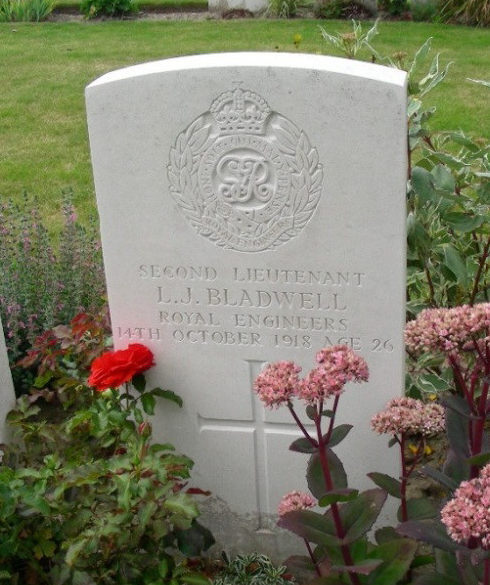
Figure 4. The Gravestone of 2nd
Lieutenant Leonard Joseph Bladwell, R.E.
(Image courtesy
of the Bladwell Family Tree)
The Probate Calendar of 1920 contained the following information regarding Leonard’s death:
BLADWELL Leonard Joseph of Kingsley-house 53 Upper Oldfield Park Bath lieutenant Royal Engineers died 14 October 1918 in Belgium Administration London 27 April to Joseph Ambrose Bladwell builder’s merchant.
Effects £240 4s 3d. (Approximately $14,850 US in 2023 currency).
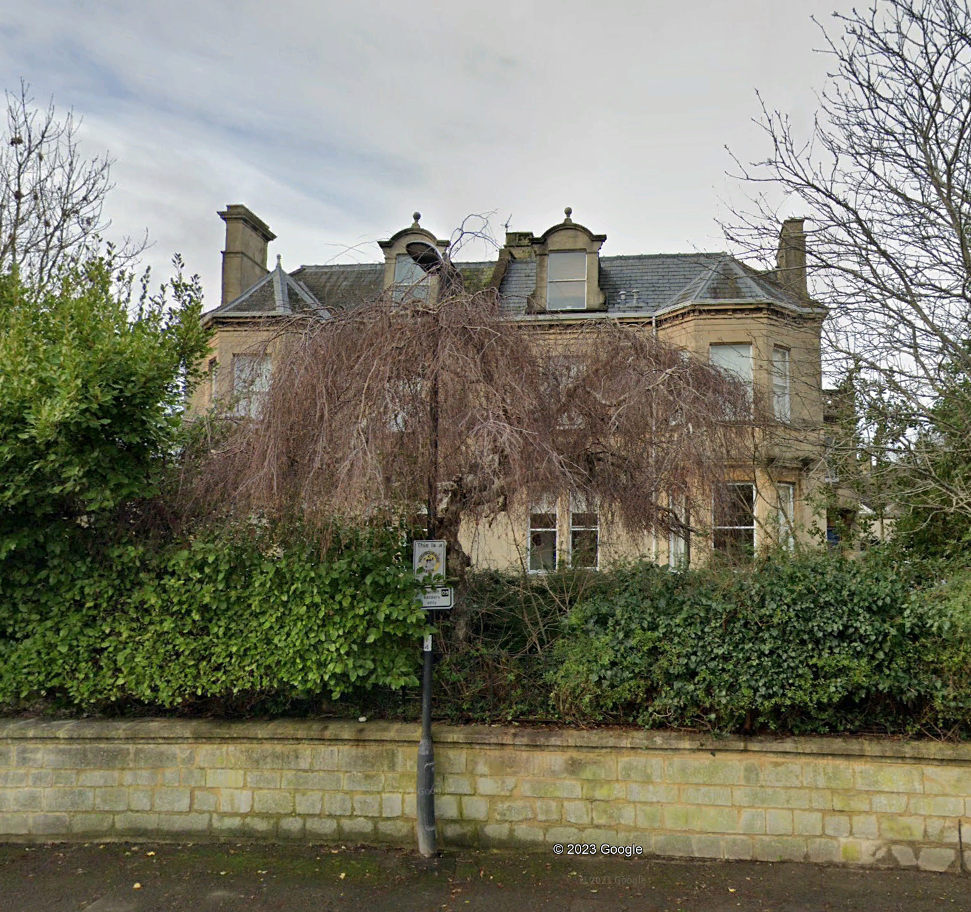
Figure 5. The Bladwell Home at 53 Upper Oldfield Park,
Bath.
(Image courtesy of Google Earth)
6. MEDALS, AWARDS AND DECORATIONS
For his service during the Great War 2nd Lieutenant Bladwell was awarded the 1914-15 Star, British War Medal and Victory Medal.
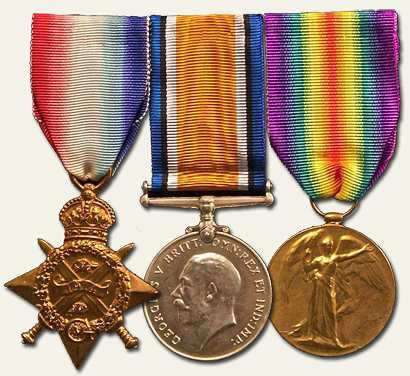
Figure 6. The 1914-15 Star, British War Medal
and Victory Medal.
(Image from the author’s collection)
NOTE: The medals above are not the medals of 2nd Lieutenant Bladwell. The image is presented here for illustrative purposes only.
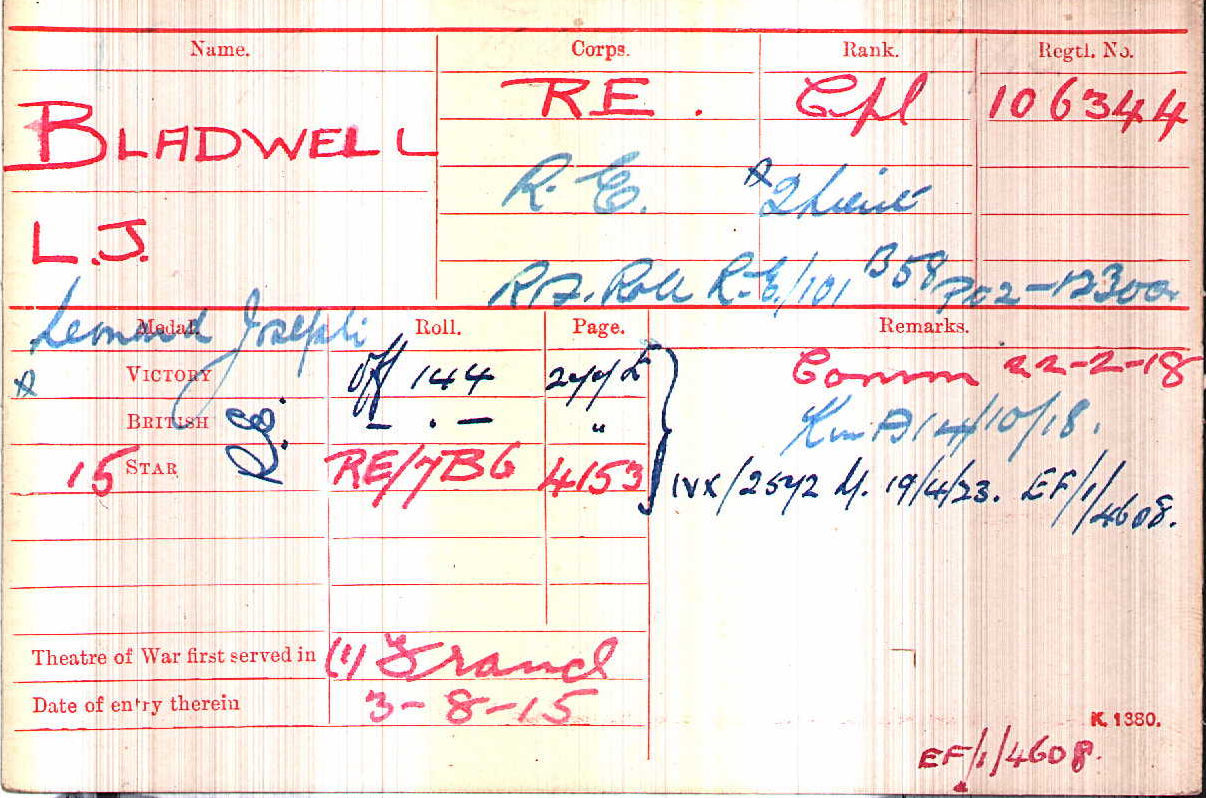
Figure 7. The Medal Index Card Showing Bladwell’s
Entitlement to the Medals.
(Image courtesy of Ancestry.com)
Note that the card shows his previous service as a Corporal in the Royal Engineers, Regimental Number 106344). It also shows his date of deployment to France on 3 August 1915, the date of his commission on 22 February 1918 and the notation that he was killed in action on 14 October 1918. The card also shows that the medals were issued to his family on 19 April 1923. The reverse of the card shows that the medals were issued to his father at the Upper Oldfield Park address. In addition to the medals, his family would have been awarded a bronze memorial plaque similar to the one shown below, with his name cast on the plaque.
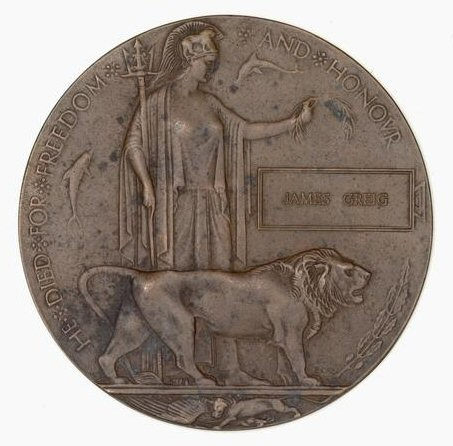
Figure 8. The Memorial Plaque.
(Image
courtesy of Wikipedia)
7. EPILOGUE
Bladwell’s story shows just how fate can intervene in one’s life and how it can create inevitable circumstances that can lead to good or to ill. Bladwell wanted to be a civil engineer, so he geared his university work to that end. After receiving his degree and joining the Army he was selected to serve in a specialized unit, namely the Royal Engineers Special Brigade. because of his scientific and engineering knowledge.
He served as a “Chemist Corporal” – although he was not a chemist – in the Special Brigade, handling and employing toxic chemicals on the battlefield from front-line trenches. He surely was placed in dangerous situations doing this work, but he was never wounded or gassed. Fate then stepped in and he was commissioned and posted to a divisional field company.
His division was not one that was heavily engaged during the last months of the war. In fact, it spent a good deal of time in Corps reserved between the date of Bladwell’s posting in February 1918 until the day of his death in October 1918. And his death did not occur while he was operating in a hazardous situation. He was with his section talking to his section sergeant when an enemy shell burst nearby. He received a mortal wound, but his sergeant did not even get a scratch. Such is life on the battlefield.
Bladwell was one of three officers killed in action in the 237th Field Company during the war. The other two men were Lieutenant George Klaassen Scott, R.E. (24 February 1917) and 2nd Lieutenant William Lees Hamilton (20 September 1917).
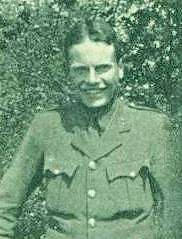
Figure 9. Lieutenant George Klaassen Scott, R.E.
(Image
courtesy of Bedales web site)
ANNEX A.
Casualties of the 237th
Field Company during the Great War
(Listed alphabetically
by date)
|
|
|
|
|
Sharp, Frederick James |
137948 |
Pioneer |
Died (H) |
19 Feb 1916 |
Fensom, Henry |
52941 |
Sapper |
Died (H) |
11 Apr 1916 |
Burford, Benjamin |
137953 |
Sapper |
Died (H) |
12 May 1916 |
May, Stanley Howard. |
137850 |
Sapper |
KIA |
9 Jun 1916 |
Grove, Joseph |
137898 |
Sapper |
KIA |
19 Jul 1916 |
Hill, George |
137885 |
Sapper |
DOW |
20 Jul 1916 |
Tegg, Arthur |
137947 |
Sapper |
Died (H) |
30 Sep 1916 |
Davis, George William |
137811 |
Corporal |
KIA |
7 Oct 1916 |
Dewe, Charles Frederick |
137721 |
Pioneer |
KIA |
7 Oct 1916 |
Sable, Ernest |
137971 |
Lance Corpl. |
KIA |
7 Oct 1916 |
Trulock, Alfred |
137930 |
Sapper |
KIA |
7 Oct 1916 |
Palmer, Arthur George |
137748 |
Sapper |
KIA |
27 Dec 1916 |
George, Herbert |
140737 |
Lance Corpl. |
KIA |
24 Feb 1917 |
Scott, George Klaassen |
|
Lieutenant |
KIA |
24 Feb 1917 |
Brown, Russell Reginald |
137952 |
Sapper |
DOW |
1 Apr 1917 |
Hunt, Adolphous |
143900 |
A/Sergeant |
DOW |
12 Jun 1917 |
Bryant, Frank |
137838 |
Driver |
DOW |
16 Jul 1917 |
Davis, Frank |
137786 |
2nd Corporal |
KIA |
9 Aug 1917 |
Boorman, Edward |
137923 |
Sapper |
KIA |
20 Sep 1917 |
Bryant, Alfred |
137958 |
2nd Corporal |
KIA |
20 Sep 1917 |
Gee, William Horace |
137831 |
Sapper |
KIA |
20 Sep 1917 |
Hamilton, William Lees |
|
2nd Lieutenant |
KIA |
20 Sep 1917 |
Smallwood, Arthur |
140449 |
Sapper |
KIA |
20 Sep 1917 |
Ping, William |
140731 |
Lance/Corpl. |
DOW |
25 Oct 1917 |
Wood, Benjamin |
184373 |
Sapper |
Died (H) |
13 Dec 1917 |
Harding, Peter |
524567 |
Sapper |
KIA |
23 Mar 1918 |
Storey, Arthur |
167856 |
Sapper |
DOW |
25 Mar 1918 |
Wishart, James |
89126 |
Sapper |
KIA |
25 Mar 1918 |
Haynes, William Ernest |
137742 |
Sapper |
DOW |
1 Apr 1918 |
Rogers, Oliver Charles |
20011 |
Sapper |
KIA |
27 May 1918 |
King, Frederick |
137908 |
Sapper |
DOW |
30 May 1918 |
Mainwaring, William |
48505 |
Sapper |
KIA |
17 Jul 1918 |
Locke, Arthur Albert |
28827 |
Sapper |
KIA |
15 Aug 1918 |
Bladwell, Leonard Joseph |
|
2nd Lieutenant |
KIA |
14 Oct 1918 |
Davey, Cecil |
137809 |
Driver |
KIA |
14 Oct 1918 |
Aird, J. |
WR/179368 |
2nd Corporal |
Died |
2 Jan 1919 |
Twitchen, Charles Thomas |
137931 |
Sergeant |
DOW |
22 Oct 1919 |
Legend: KIA – Killed in Action; DOW – Died of Wounds; Died – of disease or accidentally killed; Died (H) – died at home. Names in bold type were casualties after the arrival of 2nd Lieutenant Bladwell in the company.
Most Prominent Regimental Numbers: 137XXX. (21 of 34 Other Ranks = 61.8%)
The following is a statistical analysis of these deaths by various categories:
1. Total Company Casualties from all Causes: 37 (3 Officers, 2 senior Non-Commissioned Officers, 7 junior Non-Commissioned Officers and 25 Other Ranks)
2. Deaths by Rank
Lieutenants: 1 (2.7%)
2nd Lieutenants: 2 (5.4%)
A/Sergeant: 1 (2.7%)
Corporals: 1 (2.7%)
2nd Corporals: 3 (8.1%)
Lance Corporals: 3 (8.1%)
Sappers: 21 (56.8%)
Drivers: 2 (5.4%)
Pioneers: 2 (5.4%)
3. Deaths by Category
Killed in Action: 22 (59.5%)
Died of Wounds: 9 (24.3%)
Died of Disease or Accident: 6 (16.2%)
3. Deaths by Year
1916: 12 (32.4%)
1917: 13 (35.2%)
1918: 10 (27.0%)
1919: 2 (5.4%)
ANNEX B
The Military Service of Ernest Wilfred Bladwell.
Leonard Joseph Bladwell’s brother, Ernest Wilfred Bladwell, was born in Bath, Somerset on 15 June 1895. When the Great War began he enlisted, like his brother, in the 21st Battalion of the Royal Fusiliers as a Private, Regimental Number 2425.
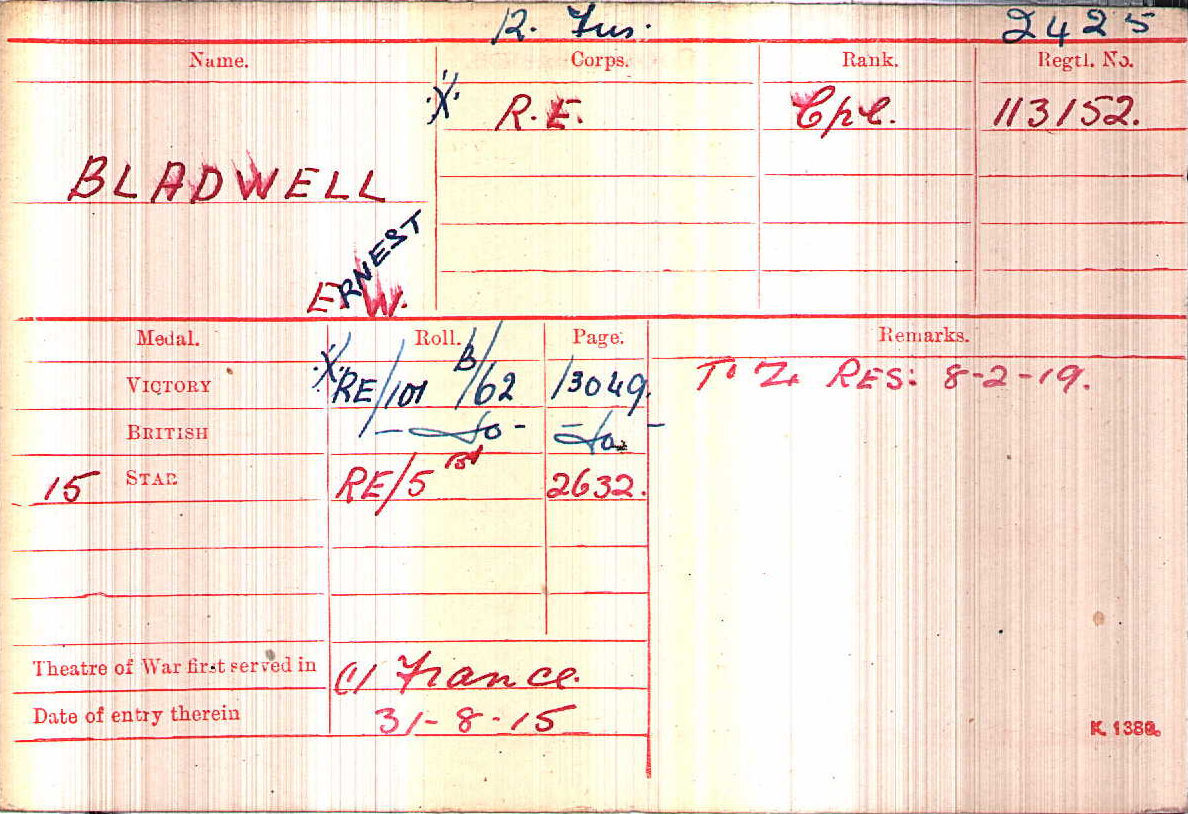
Figure 10. The Medal Index Card of 113152 Corporal Ernest W.
Bladwell, R.E.
(Image courtesy of Ancestry.com).
Ernest Bladwell’s Medal Index Card shows that he transferred to the Royal Engineer and was promoted to the rank of Corporal (Regimental Number 113152). He went to France on 31 August 1915, earned the 1914-15 Star, British War Medal and Victory Medal and was transferred to the Class “Z” Army Reserve on 8 February 1919. His Regimental Number shows that like his brother, he had been posted as a Corporal Chemist to the Special Brigade, Royal Engineers.
REFERENCES:
Books
FOULKES, C.H. “GAS!”:The Story of the Special Brigade. William Blackwood & Sons, Ltd., Edinburgh and London, 1934.
RICHTER, D. CHEMICAL SOLDIERS: British Gas Warfare in World War One. Leo Cooper, London, 1994.
Wycliffe College. Wycliffe and the War: A School Record. 1923.
Civil Documents
Letter from Bladwell to the Wycliffe Star, 1915.
Probate Calendar, 1920, p. 243.
Letter from the Commander, 237th Field Company announcing Bladwell’s death.
Digital Databases
Soldiers Died in the Great War, Naval and Military Press, Dallington, East Sussex, 1998.
Officers Died in the Great War, Naval and Military Press, Dallington, East Sussex, 1998.
Family Trees
Leonard Joseph Bladwell by Sara Salome Matthews.
Internet Web Sites
The Long, Long Trail: The Special Companies of the Royal Engineers.
Wikipedia: Battle of Albert (1916).
https://en.wikipedia.org/wiki/Battle_of_Albert_(1916)
The Long, Long Trail: Officer Training in the British Army of 1914-1918.
Commonwealth War Graves Commission.
https://www.cwgc.org/find-records/find-war-dead/casualty-details/162685/leonard-joseph-bladwell/
Bedales. G.K. Scott.
https://www.bedales.org.uk/george-klaassen-scott-27111892-24021917
London Gazette
Supplement to the London Gazette, 12 March 1918, p. 3101
Military Documents
Royal Engineers Medal Roll: 1914-15 Star: Leonard Joseph Bladwell.
Royal Engineers Medal Roll: British War Medal and Victory Medal: Leonard Joseph Bladwell (as a Corporal).
Royal Engineers Medal Roll: British War Medal and Victory Medal: Leonard Joseph Bladwell (as a 2nd Lieutenant).
Medal Index Card: Leonard Joseph Bladwell.
Royal Engineers Medal Roll: 1914-15 Star: Ernest Wilfred Bladwell.
Royal Engineers Medal Roll: British War Medal and Victory Medal: Ernest Wilfred Bladwell.
Royal Engineers Medal Roll: British War Medal and Victory Medal: Ernest Wilfred Bladwell.
Medal Index Card: Ernest Wilfred Bladwell.
Periodicals
Battle Honours of the Royal Engineers. The Royal Engineers Journal. The Institution of Royal Engineers, Chatham, Kent, 1925-1932.
Wycliffe Star, 1914.
Wycliffe Star, 1915.
ENDNOTES:
[1] Wycliffe and the War.
[2] Ibid.
[3] Family tree.
[4] It may just be that Bladwell was a Christian Scientist.
[5] The Long, Long Trail: The Special Companies of the Royal Engineers.
[6] Battle Honours of the Royal Engineers.
[7] FOULKES.
[8] It should be noted that while the 1st Battalion of the Special Brigade was present at these actions and Bladwell is thought to have served in the 1st Battalion, without his service records there is no certainty that he was actually present at these battles. However, the author thinks that there is a high probability that he was present unless he happened to be on leave when one or more of the battles took place.
[9] Wikipedia: Battle of Albert.
[10] Battle Honours of the Royal Engineers.
[11] Ibid.
[12] Ibid.
[13] FOULKES.
[14] The Long, Long Trail: Officer Training in the British Army of 1914-1918.
[15] Battle Honours of the Royal Engineers.